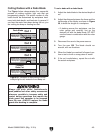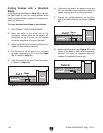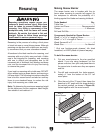
-42-
Model G0690/G0691 (Mfg. 11/10+)
Blade Tilt/ Bevel Cuts
When the blade tilt stop bolts are properly adjust-
ed (Page 65), the blade tilt handwheel allows
the operator to tilt the blade to the left, anywhere
between 0° and 45°. This is used most often when
cutting bevels, compound miters or chamfers.
Figure 58 shows an example of the blade when
tilted to 45°.
Figure 58. Blade tilted to 45° for bevel cutting on
a typical table saw.
Dado Cutting
Commonly used in furniture joinery, a dado is a
straight channel cut in the face of the workpiece.
Dadoes can be cut using either a dedicated dado
blade or a standard saw blade. Figure 59 shows
a cutaway view of a dado cut being made with a
dado blade.
Dado Blade
Workpiece
Fence
Figure 59. Example of a dado cut with a dado
blade.
DO NOT make through cuts with a dado
blade. Dado blades are only intended for
non-through cuts. Failure to heed this
warning could result in serious injury.
Installing a Dado Blade
1. DISCONNECT THE SAW FROM POWER!
2. Remove the table insert, the blade guard
assembly or riving knife, and the saw blade.
3. Attach and adjust the dado blade system
according to the dado blade manufacturer’s
instructions
4. Install the dado table insert.
Never try to dado a warped board by holding
it down against the table. If kickback occurs,
your hand will likely be pulled into the blade,
resulting in serious personal injury.
Dado blades have a higher risk of kickback
than normal blades because their larger size
applies stronger forces to the workpiece.
This risk increases relative to the depth and
width of the cut. To minimize your risk of
serious personal injury, ensure that stock
is flat and straight, and make multiple light
cuts (rather than one deep cut) to achieve
the desired cutting depth.
DO NOT make through cuts with a dado
blade. Dado blades are only intended for
non-through cuts. Failure to heed this
warning could result in serious injury.


















